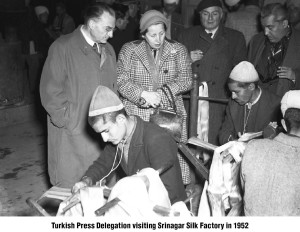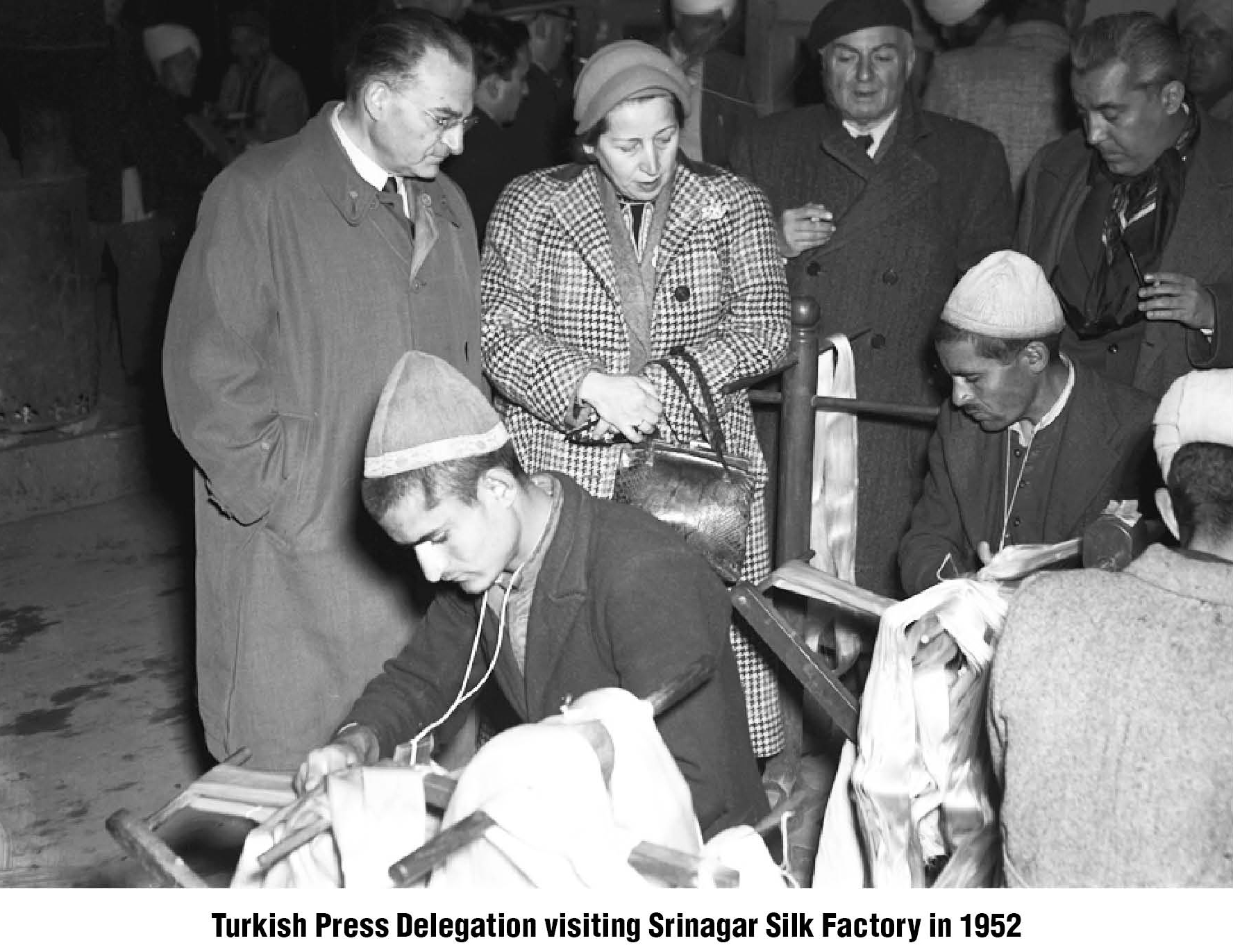From self-sufficiency to dependency
Daanish Bin Nabi
 Till 1953, Kashmir was self-sufficient and did not import anything apart from salt, tea and clothing. However, the political coup and the subsequent arrest of Prime Minister Sheikh Mohammad Abdullah on August 8, 1953 changed the political as well as economic course of Kashmir.
Till 1953, Kashmir was self-sufficient and did not import anything apart from salt, tea and clothing. However, the political coup and the subsequent arrest of Prime Minister Sheikh Mohammad Abdullah on August 8, 1953 changed the political as well as economic course of Kashmir.
In 1947, the import-export ratio of Kashmir’s trade was 1:3, indicating that Kashmir had a surplus trade. But 68 years down the line this ratio has taken a u-turn. Today the trade ratio of import-export of Kashmiri goods stands at 7:1. Kashmir now import goods of worth more than Rs 40,000 crore a year and only export goods worth Rs 7000 crore. There is a deficit of Rs 33,000 crore, which increases every year.
Import and Export of Goods
In 1951, a devastating draught hit Kashmir and there was dearth of rice. At that time, council of minster of then Prime Minster Sheikh Mohammad Abdullah suggested that Kashmir should import food grains from Punjab. But Sheikh Abdullah refused and instructed people to consume potatoes and corn instead of rice and wheat. The Prime Minister argued with his minister that it will make Kashmiris dependent on others and will set a bad precedence. The political coup of Prime Minister in 1953 changed the self-sufficient status of Kashmir. Whether Sheikh Abdullah’s austerity was pragmatic or not is debatable. But the message it send across is something which every Kashmir should appreciate and stands out in current dispensation.
After Sheikh’s arrest, a public rally was addressed by his successor Ghulam Mohammad Bakshi. At the rally, a man known as Khalil-e-Kashmir reminded the Prime Minster that we do not have rice to eat. Bakshi, in response said “Drage jin kor aaes band wuen wochu tuyh latan te aasi bati te watan te aase bate” (The demon of draught has been captured; now food grains will be on every road and corner). Subsequently, Bakshi introduced the subsidised rice to Kashmir for the first time as a token from New Delhi. This was for the first in history of Kashmir that Kashmiris were made to believe that they are dependent on New Delhi.
Kashmir’s Road Connectivity
The three imported goods – salt, tea and clothing – used to come to Kashmir from natural roads like Rawalpindi-Srinagar highway, or Sailkot-Jammu road. The manufactured road which Kashmiris are forced to treat as “National Highway” was just a cart road. This road was only used by the Maharajas of Kashmir, their families, relatives and administrative officials. Any outsider who had to travel via cart road had to seek permission from Kashmir government first. Rawalpindi-Srinagar highway was open for the common masses of Kashmir and Silk Road was the international road of Kashmir that connected Valley with Central Asia and the rest of the world.
As far as the railway connectivity is concerned, the first mega railway project was inaugurated by Maharaja Pratap Singh in 1897 that connected Sailkot-Jammu. It was the first railway line Jammu Kashmir. In 1898, Pratap Singh again called upon a British consultancy to conceive the idea of linking Srinagar and Sailkot. This scheme was approved by Maharaja Pratap Singh in 1902. The railways track was to be constructed via Reasi and Mughal road. But due to lack of funds, Kashmir government was not able to complete the project. Kashmir survived without railway connectivity because of Valley’s connectivity by old routes.
Indigenous Industries
From small hand-made goods to large industrial products, the present Kashmir is entirely dependent on Indian states. Today, we are dependent on food grains, rice, mutton, beef, poultry, fish, milk and packaged goods of every kind, which Kashmiris consume on a large scale. Until recently, Kashmiris produced a large chunk of eatables indigenously but now we import it from other parts of India. Kashmir would export more than 90 percent of apple, walnuts, apricot, dry-fruits and pears etc in horticulture sector which now also drastically has come down.
The silk produced in Kashmir was once famous all over world. But the historic Silk Factory of Kashmir which was built in posh area of Rambagh-Solina is non-existent today. A vast five storey concrete building of Income Tax and Excise department has replaced the Silk Factory that was one of the major employment generating units for the unemployed people. Records say that the unit was feeding more than 3000 people.
Kashmir was also rich in handicrafts. Kashmir already had many handicraft units that were introduced after contacts with Central Asia. Shah-i-Hamdan introduced 27 new small units like carpet weaving, wood carving, embroidery, paper machie, namda, gaba (traditional rugs). By this time Kashmir had total of 50 indigenous units providing employment to hundreds of people. Unfortunately, much of these units either are in deplorable state today or are non-existent.
Kashmir had wool industry and used to weave chadar (wraps) and had units of textile. These units produced Harris wool. It is said that Harris wool is today’s Reid and Tailor. These units used to weave it on vertical looms. Kashmir now has completely stopped to weave such costly wool owing to shutdown of these units. In today’s international market a suit length of Harris wool sells at more than 20, 000 rupees. We have the raw material to produce the Harris wool but there are no production units.
The economy today heavily relies on service sector. This type of economy is never good as population and therefore demands for tangible products keeps on increasing. In trade the situation is no better as most of the retail units only sell those products that are being imported.
Cheshma Shashi Milk factory, Killey Khan factory in Soura, HMT watch factory in HMT area of Srinagar all saw gradual decline with gross negligence and tacit approval of state government.
Factors Responsible for Decline of Industries
There are many factors responsible for gradual decline of Kashmir’s industrial economy. Political turmoil right from the year 1947 is one of the major causes for decline of industrial units in Kashmir. From 1947 to 1953 some sort of independent economic foundation for Kashmir was laid in the form of land to tiller scheme and other affiliated schemes, but overall Kashmir’s industries were allowed to rot.
Social changes also led to the decline of industries in Kashmir. The educated youth distanced from their ancestral businesses like farming, handicrafts manufacturing and trade or orchards’ produce. Today, from a barber’s shop to paddy fields and household helpers we are dependent on states like West Bengal, Uttar Pradesh, and Bihar.
Kashmir’s own inefficiency was fully exploited by New Delhi as it took her a short time to make Kashmiris dependent on aid. New Delhi under grab of special grants and packages has only benefited projects like National Hydroelectric Power Corporation (NHPC) and roads that connect Kashmir to rest of India, for integration of Kashmir.
Myth of Packages
From subsidised rice to special grants and crores of relief packages – all have proved to be a hoax. Indian Prime Ministers Rajiv Gandhi, H D Deve Gowda, Manmohan Singh and Narendra Modi till date have provided a total sum of Rs 114, 301 crores as packages. Noted Kashmiri economist, Prof. Nisar Ali says, “More than 75 percent money of these packages was spend on projects like NHPC, India’s defence projects in Kashmir and on road and railways and rest 25 percent is used on education, health and infrastructure. All these packages are mere eye. Rather than giving Kashmir a political package, New Delhi has to address the main problem that’s the political question of Kashmir.”
While lamenting on the recent package given by Prime Minster Narendra Modi, the Chairman of Kashmir Economic Alliance (KEA), Mohammad Yasin Khan said, “Rs 80,000 crore package is a conspiracy to trifurcate Jammu and Kashmir on communal lines. In the name of development, mere Rs 6500 crore have been allotted to the Kashmir province whereas Rs. 13,000 crore have been given to Ladakh. A huge chunk of Rs 11, 000 crore has been given to Jammu.”
Civil Society member Shakeel Qalandar said, “We have had 1900 days of curfews and hartals in past 26 years. Government of India or state government has not compensated us even for one day. Per day state exchequer had to bear minimum cost of 100 crore. By that yardstick Kashmir has lost Rs 1,90,000 crore wealth in last 26 years. Banks too were submerged in last year’s flood, still they charged us the interests for the month of September. We have also paid interests for the 1900 days of curfews and hartals. Likewise, industries of Kashmir have also paid interests for these days and this sum goes up in trillions that our Kashmir has lost.”
Recently, launched #AskHurriyat initiative by Hurriyat (M) chairman Mirwaiz Umar Farooq’s which aimed to bridge the gap between people and leadership. This freshly initiative fits right in the dependency scheme of things. One user asked Mirwaiz why they don’t boycott Indian goods, he responded, “We could only boycott if we produce something of our own. Self reliance is the key.”
The foundation of self-reliance was set by Prime Minister Sheikh Abdullah but it was gradually eroded by Kashmiris, installed government and New Delhi. As per economic survey report there are around six lakh educated unemployed youth in Jammu and Kashmir while the Civil Society of Kashmir puts the figure around one million. If Kashmir’s indigenous industries are again given a shot it can get rid of the growing unemployment problem of Jammu Kashmir. Instead, of spending packages on NHPC there are units that are in dire need of revamp. Kashmir has completed a journey from self-sufficiency to dependency.
The author can be mailed at daanishnabi@gmail.com





